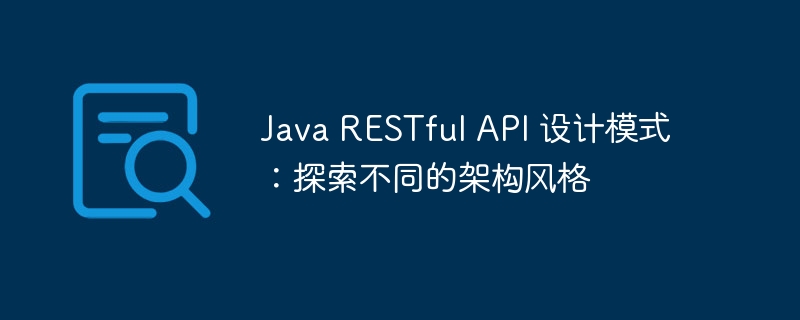

Java RESTful API design pattern is a vital part of modern software development. In this article, PHP editor Strawberry will lead you to explore different architectural styles and gain an in-depth understanding of the key concepts and best practices of RESTful API design. Whether you are a beginner or an experienced developer, this article will reveal how to build an efficient and maintainable RESTful API through reasonable design patterns to add more advantages to your project.
1. RESTful resources
RESTful resources are a core component of the API. They represent entities of interest in the application, such as customers, products, or orders. Resources are identified using URIs and can be manipulated through Http methods (GET, POST, PUT, DELETE).
@Entity
public class Customer {
@Id
@GeneratedValue(strategy=GenerationType.AUTO)
private Long id;
private String name;
private String email;
// ...
}2. Hypermedia
The Hypermedia API provides additional information such as links to available operations, formatting specifications, and related resources. This enables clients to dynamically browse and interact with the API without having to know all of its endpoints in advance.
@GetMapping(produces = {MediaType.APPLICATION_HAL_JSON_VALUE})
public ResponseEntity<Resource<Customer>> getCustomer(@PathVariable Long id) {
Customer customer = customerService.findById(id);
Resource<Customer> resource = new Resource<>(customer);
resource.add(linkTo(methodOn(CustomerController.class).getCustomer(id)).withSelfRel());
resource.add(linkTo(methodOn(CustomerController.class).getAllCustomers()).withRel("customers"));
return ResponseEntity.ok(resource);
}3. HATEOAS
HATEOAS (Hypertext as Application State Engine) is a RESTful architectural pattern that uses hypermedia to make clients aware of available operations and resources. By embedding state into API responses, HATEOAS eliminates the need for documentation and facilitates API discoverability.
@GetMapping(produces = {MediaType.APPLICATION_HAL_jsON_VALUE})
public ResponseEntity<Resource<Customer>> getCustomer(@PathVariable Long id) {
Customer customer = customerService.findById(id);
Resource<Customer> resource = new Resource<>(customer);
resource.add(linkTo(methodOn(CustomerController.class).getCustomer(id)).withSelfRel());
resource.add(linkTo(methodOn(CustomerController.class).getAllCustomers()).withRel("customers"));
resource.add(linkTo(methodOn(CustomerController.class).updateCustomer(id, null)).withRel("update"));
resource.add(linkTo(methodOn(CustomerController.class).deleteCustomer(id)).withRel("delete"));
return ResponseEntity.ok(resource);
}4. Microservices
Microservices is an architectural style in which applications are broken down into small, loosely coupled services. Each microservice is responsible for a specific function and communicates with other services through APIs. This model increases scalability, flexibility, and also simplifies maintenance and deployment.
@SpringBootApplication
public class CustomerMicroserviceApplication {
public static void main(String[] args) {
springApplication.run(CustomerMicroserviceApplication.class, args);
}
}
@RestController
@RequestMapping("/api/customers")
public class CustomerController {
@Autowired
private CustomerService customerService;
@GetMapping
public List<Customer> getAllCustomers() {
return customerService.findAll();
}
@GetMapping("/{id}")
public Customer getCustomer(@PathVariable Long id) {
return customerService.findById(id);
}
@PostMapping
public Customer createCustomer(@RequestBody Customer customer) {
return customerService.save(customer);
}
@PutMapping("/{id}")
public Customer updateCustomer(@PathVariable Long id, @RequestBody Customer customer) {
return customerService.update(id, customer);
}
@DeleteMapping("/{id}")
public void deleteCustomer(@PathVariable Long id) {
customerService.delete(id);
}
}Choose the best mode
Choosing the appropriate RESTful API design pattern depends on the specific requirements of the application. For simple and static APIs, the RESTful resource model is sufficient. For more complex APIs, Hypermedia or HATEOAS can provide better discoverability. The microservices pattern is suitable for large-scale applications that require scalability and flexibility.
in conclusion
RESTful API design patterns provide guidance to help developers create efficient, maintainable, and scalable APIs. By understanding the different architectural styles, you can choose the pattern that best suits your application needs, resulting in better API design and interaction.
The above is the detailed content of Java RESTful API Design Patterns: Exploring Different Architectural Styles. For more information, please follow other related articles on the PHP Chinese website!
 The difference between distributed and microservices
The difference between distributed and microservices
 The difference between export and export default
The difference between export and export default
 how to hide ip address
how to hide ip address
 What is the core of a database system?
What is the core of a database system?
 Introduction to dex concept digital currency
Introduction to dex concept digital currency
 How to solve discuz database error
How to solve discuz database error
 How to open vcf file in windows
How to open vcf file in windows
 0x00000006 What to do if the printer cannot be connected?
0x00000006 What to do if the printer cannot be connected?




